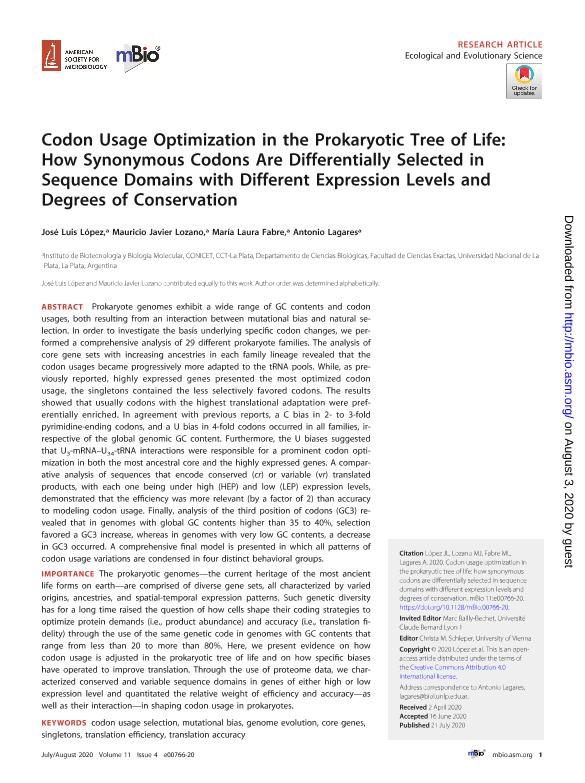Artículo
Codon usage optimization in the prokaryotic tree of life: how synonymous codons are differentially selected in sequence domains with different expression levels and degrees of conservation
Fecha de publicación:
21/07/2020
Editorial:
American Society for Microbiology
Revista:
mBio
ISSN:
2161-2129
e-ISSN:
2150-7511
Idioma:
Inglés
Tipo de recurso:
Artículo publicado
Clasificación temática:
Resumen
Prokaryote genomes exhibit a wide range of GC contents and codon usages, both resulting from an interaction between mutational bias and natural selection. In order to investigate the basis underlying specific codon changes, we performed a comprehensive analysis of 29 different prokaryote families. The analysis of core gene sets with increasing ancestries in each family lineage revealed that the codon usages became progressively more adapted to the tRNA pools. While, as previously reported, highly expressed genes presented the most optimized codon usage, the singletons contained the less selectively favored codons. The results showed that usually codons with the highest translational adaptation were preferentially enriched. In agreement with previous reports, a C bias in 2- to 3-fold pyrimidine-ending codons, and a U bias in 4-fold codons occurred in all families, irrespective of the global genomic GC content. Furthermore, the U biases suggested that U3-mRNA–U34-tRNA interactions were responsible for a prominent codon optimization in both the most ancestral core and the highly expressed genes. A comparative analysis of sequences that encode conserved (cr) or variable (vr) translated products, with each one being under high (HEP) and low (LEP) expression levels, demonstrated that the efficiency was more relevant (by a factor of 2) than accuracy to modeling codon usage. Finally, analysis of the third position of codons (GC3) revealed that in genomes with global GC contents higher than 35 to 40%, selection favored a GC3 increase, whereas in genomes with very low GC contents, a decrease in GC3 occurred. A comprehensive final model is presented in which all patterns of codon usage variations are condensed in four distinct behavioral groups. IMPORTANCE The prokaryotic genomes—the current heritage of the most ancient life forms on earth—are comprised of diverse gene sets, all characterized by varied origins, ancestries, and spatial-temporal expression patterns. Such genetic diversity has for a long time raised the question of how cells shape their coding strategies to optimize protein demands (i.e., product abundance) and accuracy (i.e., translation fidelity) through the use of the same genetic code in genomes with GC contents that range from less than 20 to more than 80%. Here, we present evidence on how codon usage is adjusted in the prokaryotic tree of life and on how specific biases have operated to improve translation. Through the use of proteome data, we characterized conserved and variable sequence domains in genes of either high or low expression level and quantitated the relative weight of efficiency and accuracy—as well as their interaction—in shaping codon usage in prokaryotes.
Archivos asociados
Licencia
Identificadores
Colecciones
Articulos(IBBM)
Articulos de INST.DE BIOTECNOLOGIA Y BIOLOGIA MOLECULAR
Articulos de INST.DE BIOTECNOLOGIA Y BIOLOGIA MOLECULAR
Citación
López, José Luis; Lozano, Mauricio Javier; Fabre, Maria Laura; Lagares, Antonio; Codon usage optimization in the prokaryotic tree of life: how synonymous codons are differentially selected in sequence domains with different expression levels and degrees of conservation; American Society for Microbiology; mBio; 11; 4; 21-7-2020; 1-20
Compartir
Altmétricas




